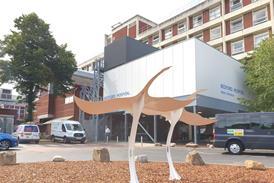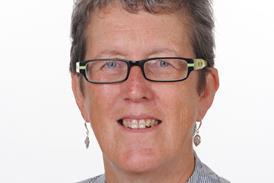The aim of national support teams is to reflect back the work of trusts and local authorities and to support change, as director Cathy Hamlyn told HSJ
The concept of national support is sometimes viewed with suspicion, or as a proxy for more inspection, form filling and targets. Yet Department of Health national support teams director Cathy Hamlyn remains clear that the initiative's role is to support - to hold up a mirror to primary care trusts' and local authorities' existing work on health inequalities and to suggest strategies and avenues for further improvement.
"We come to work with PCTs by invitation," she says. "Where organisations may have some challenges in particular areas, we will offer our services, but we're not forced on them."
The support teams visit PCTs, offering a combination of support, analysis and feedback. Ms Hamlyn also stresses that their health inequalities work is "very focused on helping PCTs to deliver on the 2010 target". She helped establish the teams at the start of 2006, following her research on the national support methodologies used for acute sector orthopaedic and accident and emergency waiting times.
Quick feedback
The teams were a commitment in the DH's 2004 Choosing Health: making healthy choices easier and Ms Hamlyn adds that her aim was to create processes for public health that were as robust as those applied to the acute sector.
She adds: "One aspect we needed to change was to increase emphasis on partnership between health and local government. We see our role in providing support equally to both to address health inequalities, as well as to raise emphasis on personal health issues in the context of public health."
The first national support team was launched in early 2006, addressing sexual health, followed that autumn by tobacco control. The health inequalities team was launched at the start of 2007, followed by teenage pregnancy and obesity teams. Alcohol and infant mortality teams will be introduced this autumn, bringing the total to seven.
A health inequalities support team diagnostic visit usually runs over four days. On the first, a plenary session run with PCT and local authority managers as well as a range of staff leads on specific aspects covers introductions, where local staff are invited to describe their progress.
This is followed by a series of one-to-one discussions with staff and workshops using the health inequalities toolkit to drill down and identify areas contributing to health inequalities gaps (usually acute coronary heart disease, cancer, tobacco control, seasonal excess deaths and infant mortality). The workshops run in parallel, using a systematic review process based on self-audit workbook tools and involving specialists from the PCT, local authority or acute trust.
Within two days the support team report back in a final plenary presentation. After the diagnostic visit, the team send the organisations two reports: one on strategic issues and another going into specific local issues. A follow-up meeting is then held with PCT and local authority directors to discuss the findings and agree on a follow-up package and possible sources of further help.
Ms Hamlyn regards the "very quick feedback, reporting identified strengths and good practices, and also areas for recommendations for progress" as a unique feature of the method.
Local issues
As well as broader strategic issues such as leadership, partnership and having a strategy to hit the 2010 target, she describes finding local issues such as community engagement, quality and accessibility of frontline primary care services, and data collection and use.
Ms Hamlyn outlines the importance of involving chief executives: "Leadership is very important. A repeated learning point is that health inequalities can't just be left to directors of public health: it needs to be led by chief execs in local authorities and PCTs and everybody has some kind of role.
"Part of our work points out how others can contribute. Local authorities are often doing longer-term health inequalities stuff and they're not always clear on how they contribute to the 2010 targets prior to us visiting.
"We emphasise community engagement of their frontline staff, using their contacts to deliver basic messages about how to seek help to increase early diagnosis (especially in CHD - early access means better outcome). And we're genuinely supportive of areas and are there to advise and help.
"We found some very good examples of practice, but systematising and scaling work are big issues. In Birmingham, they're systematically going out to seek people in the most vulnerable parts - a good example of industrial scaling.
Forging ahead
"Good partnership working across health and local government involves using joint partnership structures to forge ahead. We often present back organisations' own data, but some have excellent data analysis, used well in communication with their public. Hull do this very well."
Are the national support teams seeing the links developing with commissioning? Ms Hamlyn candidly admits that "in many places, they're at the start of that process. In the past, public health was seen as separate from the main commissioning process, which just focused on acute trusts.
"In the best places, it's a joint activity, informing commissioning of acute services, but also using skills to commission public health. With world class commissioning, we need to bring this properly together. A common recommendation of ours is to use commissioning to push public health - when a PCT is commissioning acute care, or community services, to build in health gain to the contracts.
"Equally, we recommend health gain schedules to include weight management, smoking and alcohol and to spell out how professionals can train the population to do group interventions. We point out where commissioning can be used, but it hasn't happened until now. With the world class commissioning thrust, we will hopefully see it strengthened."
Best quality
Ms Hamlyn concludes that "primary care is vital: the strong lesson is of its importance to health inequalities. Getting the best-quality primary care into local areas is a very strong lesson and a major theme we recommend. PCTs need to get further engaged in looking at all ways of providing different types of primary care services".
Delivery manager Chris Bentley, who devised the health inequalities support team's self-audit workbook tools, stresses that the diagnostic approach derived from the "Christmas tree" diagnostic examines 13 issues, to determine whether a one-to-one intervention will have the best impact at population level.
"Although people use interventions, it can be ad hoc and random and not everyone who can benefit gets equal access to get equal outcome. Statins to manage cholesterol went first to middle-class educated people in areas with fewer financial pressures. People in more deprived communities and people with low IQs and ethnic minority communities tend to miss out on high levels of evidence-based interventions."
Vulnerable people
Mr Bentley explains how during the team's visit, "in the afternoon of the first day, we run workshops on the major killers and contributors to death: usually CHD and cancer, tobacco control, infant mortality, seasonal excess deaths, diabetes and chronic obstructive pulmonary disorder.
"Our framework on one side is about designing services to deliver effective interventions. The other side shows how the population uses and is supported to use these services. The national service frameworks etc work on the system provision side, but the other side is about how to get the population into the system.
"We find a lot of deprived people are missing from GP registers: if so, they obviously won't get effective interventions. Once registered, do they get a good deal and extra support if needed? And is there support for vulnerable people to self-manage - explaining to people with low IQ or English as a second language that some pills must be taken with meals, some after meals etc?
"A range of factors need to be taken into account. We use the overall framework for each issue we look at and specific questions under each of 13 headings in the various topic areas."
Finding weaknesses
Mr Bentley explains how the support teams workshops work through issues with a good mixed group from hospitals, community services and GP practices, going through the diagnostic question by question to find weaknesses and gaps and work out how to address them.
"After the visit, they leave with workbooks, so they can iterate the process. They develop action plans from our visit. We offer to go back and re-run sessions with a wider audience and independent facilitator."
Mr Bentley draws a few main lessons for progress. "At the moment, there's a mystical feel to hitting health inequalities targets. Some see it as 'a public health thing', all to do with the local authority - which is blatantly not the case. We have to demystify it.
"Much of it is common sense. We can't deliver on health inequalities with poor primary care - and system and scale are crucial.
"The most important criteria is to see if an intervention can work across the board; some may do some in some places, but we must systematically deliver the things we know to work on a wide scale to change health at population level on an industrial scale."



























No comments yet